Design Implication of a Distribution Transformer in Solar Power Plants Based on Its Harmonic Profile
Abstract
:1. Introduction
2. Fundamental Calculations Required for SPP
3. Study Case for SPP Transformer Design
3.1. Assessment of Standard Design vs. Specific Harmonic Profile Design
3.1.1. Standard Design
3.1.2. Manufacturer Design System Parameters Results
3.1.3. FEM Analysis Using ANSYS Maxwell®
3.1.4. Simulation Results for a Standard Design
3.1.5. Simulation Result for Harmonic Profile Design
4. Results and Discussion
5. Conclusions
Author Contributions
Funding
Institutional Review Board Statement
Informed Consent Statement
Data Availability Statement
Acknowledgments
Conflicts of Interest
Nomenclature
| Abbreviation | Definition |
| B | Magnetic Flux Density |
| FEM | Finite Element Modeling |
| Correction Factor for Winding Eddy–Current Losses | |
| Correction Factor for Other Stray Losses | |
| HV | High Voltage |
| Current | |
| Resistance | |
| LV | Low Voltage |
| MMF | Manufacturer Material Factor |
| Losses | |
| Winding Eddy–Current Losses | |
| Per-unit Winding Eddy–Current Losses | |
| Winding Eddy–Current Losses when no Harmonic Currents exist | |
| Total Losses of a Transformer | |
| Per-unit Load Losses | |
| No Load Losses | |
| Other Stray Losses | |
| Per-unit Other Stray Losses | |
| Per-unit Total Stray Losses | |
| PV | Photovoltaic |
| RMS | Root Mean Square or Effective |
| Apparent Power | |
| SPG | Solar Power Generation |
| SPP | Solar Power Plant |
| Voltage | |
| W | Watts |
| WPP | Wind Power Plants |
Appendix A
| AC Output Side | Rated Power | 2.7/2.7 | MW/MVA |
| AC Rated Voltage (3-Phase) | 600 + 10% | V | |
| Rated Frequency | 60/50 | Hz | |
| Rated Current | 2598 | A RMS | |
| Power Factor | 0.926 | Lead/Lag | |
| Maximum Current | 2598 | A RMS | |
| Maximum Efficiency | 98.80 | % | |
| Rated Efficiency | 98.50 | % | |
| DC Input Side | Maximum DC voltage | 1500 | V |
| DC Voltage operation range | 875–1200 | V |
| Distribution Transformer Data | ||
|---|---|---|
| Operation Configuration | Step-up low voltage input and high voltage output | |
| Rated Voltage | 34.5/0.630 | kV |
| Rated Power | 2.7 | MVA |
| Rise Temperature | 65 | °C |
| Rated Frequency | 60 | Hz |
| Impedance | 4.27 | % |
| Efficiency | 99.25 | % |
| Connection | Delta/Star-Grounded | |
| HV and LV Winding material | Aluminum |
| Harmonic Order | Phase A (A) | Phase A (%) | Phase B (A) | Phase B (%) | Phase C (A) | Phase C (%) |
|---|---|---|---|---|---|---|
| 1 | 2610.37 | 99.988 | 2572.83 | 99.981 | 2661.82 | 99.989 |
| 2 | 10.93 | 0.418 | 21.5 | 0.835 | 6.45 | 0.242 |
| 3 | 15.14 | 0.58 | 25.49 | 0.991 | 20.7 | 0.778 |
| 4 | 3.57 | 0.137 | 5.84 | 0.227 | 6.05 | 0.227 |
| 5 | 31.78 | 1.217 | 32.94 | 1.28 | 29.07 | 1.092 |
| 6 | 1.51 | 0.058 | 1.86 | 0.072 | 1.16 | 0.044 |
| 7 | 9.96 | 0.382 | 9.89 | 0.384 | 11.33 | 0.426 |
| 8 | 3.9 | 0.149 | 2.06 | 0.08 | 2.48 | 0.093 |
| 9 | 0.8 | 0.031 | 1.03 | 0.04 | 1.69 | 0.064 |
| 10 | 0.3 | 0.011 | 2.24 | 0.087 | 1.93 | 0.073 |
| 11 | 4.81 | 0.184 | 5.0 | 0.195 | 4.4 | 0.165 |
| 12 | 0.86 | 0.033 | 1.02 | 0.04 | 0.76 | 0.028 |
| 13 | 1.31 | 0.05 | 0.77 | 0.03 | 1.47 | 0.055 |
| 14 | 0.19 | 0.007 | 1.94 | 0.075 | 2.12 | 0.08 |
| 15 | 0.5 | 0.019 | 1.04 | 0.04 | 1.23 | 0.046 |
| 16 | 1.18 | 0.045 | 1.08 | 0.042 | 2.01 | 0.075 |
| 17 | 2.27 | 0.087 | 3.05 | 0.118 | 0.77 | 0.029 |
| 18 | 0.75 | 0.029 | 0.22 | 0.009 | 0.94 | 0.035 |
| 19 | 2.53 | 0.097 | 4.09 | 0.159 | 2.91 | 0.109 |
| 20 | 2.9 | 0.111 | 1.69 | 0.066 | 1.67 | 0.063 |
| 21 | 1.08 | 0.041 | 1.02 | 0.04 | 0.07 | 0.003 |
| 22 | 3.34 | 0.128 | 3.78 | 0.147 | 3.22 | 0.121 |
| 23 | 0.9 | 0.034 | 1.16 | 0.045 | 0.43 | 0.016 |
| 24 | 0.13 | 0.005 | 0.43 | 0.017 | 0.46 | 0.017 |
| 25 | 0.63 | 0.024 | 0.57 | 0.022 | 0.46 | 0.017 |
| 26 | 1.76 | 0.067 | 2.15 | 0.084 | 2.02 | 0.076 |
| 27 | 0.24 | 0.009 | 0.27 | 0.011 | 0.31 | 0.011 |
| 28 | 0.54 | 0.021 | 0.98 | 0.038 | 0.89 | 0.034 |
| 29 | 0.22 | 0.008 | 0.25 | 0.01 | 0.05 | 0.002 |
| 30 | 0.09 | 0.003 | 0.26 | 0.01 | 0.28 | 0.011 |
| 31 | 0.09 | 0.003 | 0.11 | 0.004 | 0.05 | 0.002 |
| 32 | 0.22 | 0.009 | 0.21 | 0.008 | 0.32 | 0.012 |
| 33 | 0.12 | 0.005 | 0.02 | 0.001 | 0.15 | 0.006 |
| 34 | 0.05 | 0.002 | 0.22 | 0.009 | 0.21 | 0.008 |
| 35 | 0.03 | 0.001 | 0.07 | 0.003 | 0.08 | 0.003 |
| 36 | 0.17 | 0.006 | 0.14 | 0.005 | 0.16 | 0.006 |
| 37 | 0.13 | 0.005 | 0.23 | 0.009 | 0.19 | 0.007 |
| 38 | 0.19 | 0.007 | 0.26 | 0.01 | 0.18 | 0.007 |
| 39 | 0.05 | 0.002 | 0.06 | 0.002 | 0.08 | 0.003 |
| 40 | 0.1 | 0.004 | 0.25 | 0.01 | 0.25 | 0.01 |
| 41 | 0.12 | 0.005 | 0.1 | 0.004 | 0.15 | 0.006 |
| 42 | 0.07 | 0.002 | 0.04 | 0.001 | 0.03 | 0.001 |
| 43 | 0.1 | 0.004 | 0.12 | 0.005 | 0.07 | 0.003 |
| 44 | 0.25 | 0.01 | 0.22 | 0.009 | 0.24 | 0.009 |
| 45 | 0.06 | 0.002 | 0.08 | 0.003 | 0.01 | 0 |
| 46 | 0.81 | 0.031 | 0.94 | 0.037 | 0.81 | 0.03 |
| 47 | 0.06 | 0.002 | 0.06 | 0.002 | 0.06 | 0.002 |
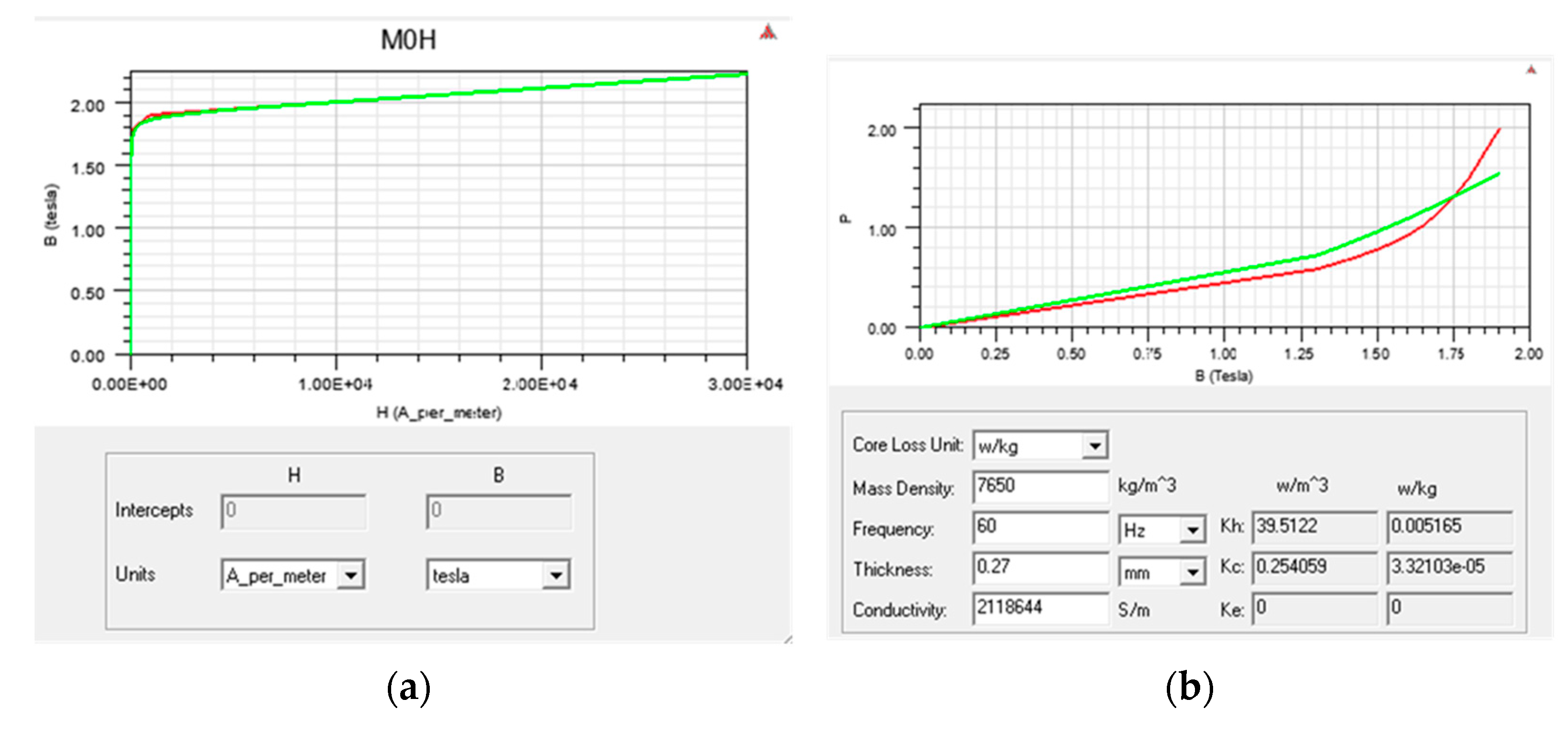
References
- Said, D.M.; Nor, K.M. Effects of harmonics on distribution transformers. In Proceedings of the 2008 Australasian Universities Power Engineering Conference (AUPEC’08), Sydney, Australia, 14–17 December 2008. [Google Scholar]
- IEEE Std. C. 57-110. IEEE Recommended Practice for Establishing Liquid-Filled and Dry-Type Power and Distribution Transformer Capability When Supplying Non-Sinusoidal Load Currents; IEEE Press and Publication: Piscataway, NJ, USA, 2018; pp. 1–68. [Google Scholar]
- Yazdani-Asramia, M.; Mirzaiea, M.; Akmal, A.A.S. Investigation on Impact of Current Harmonic Contents on the Distribution Transformer Losses and Remaining Life. In Proceedings of the IEEE International Conference on Power and Energy (PECon2010), Kuala Lumpur, Malaysia, 29 November–1 December 2010. [Google Scholar]
- Yazdani-Asrami, M.; Sadati, S.M.B.; Samadaei, E. Harmonic Study for MDF Industries: A Case Study. In Proceedings of the IEEE Applied Power Electronics Colloquium (IAPEC), Johor Bahru, Malaysia, 18–19 April 2011. [Google Scholar]
- Yazdani-Asrami, M.; Song, W.; Zhang, M.; Yuan, W.; Pei, X. AC Transport Loss in Superconductors Carrying Harmonic Current with Different Phase Angles for Large-Scale Power Components. IEEE Trans. Appl. Supercond. 2021, 31, 1–5. [Google Scholar] [CrossRef]
- Sadati, S.B.; Yazdani-Asrami, M.; Taghipour, M. Effects of Harmonic Current Content and Ambient Temperature on Load Ability and Life Time of Distribution Transformers. Int. Rev. Electr. Eng. 2010, 5, 1444–1451. [Google Scholar]
- Mirzaie, M.; Yazdani-Asrami, M.; Sadati, S.B.; Akmal, A.S. Impacts of Non-Sinusoidal Load Currents on Distribution Transformer Losses-Part I: Theoretical Aspects and Finite Element Based Simulation. Int. Rev. Electr. Eng. 2011, 6, 2207–2214. [Google Scholar]
- Mirzaie, M.; Yazdani-Asrami, M.; Sadati, S.B.; Akmal, A.S. Impacts of Non-Sinusoidal Load Currents on Distribution Transformer Losses-Part II: Standard Aspects and Experimental Measurement. Int. Rev. Electr. Eng. 2011, 6, 2215–2220. [Google Scholar]
- Yazdani-Asrami, M.; Mirzaiea, M.; Akmal, A.A.S. No-load loss calculation of distribution transformers supplied by nonsinusoidal voltage using three-dimensional finite element analysis. Energy 2013, 50, 205–219. [Google Scholar] [CrossRef]
- Daut, I.; Hasan, S.; Taib, S. Magnetizing Current, Harmonic Content and Power Factor as the Indicators of Transformer Core Saturation. J. Clean Energy Technol. 2013, 1, 304–307. [Google Scholar] [CrossRef] [Green Version]
- Jayasinghe, N.R.; Lucas, J.R.; Perera, K.B.I.M. Power System Harmonic Effects on Distribution Transformers and New Design Consideration for k Factor Transformers; IEE Sri Lanka Annual Sessions; Lanka Transformers Ltd.: Moratuwa, Sri Lanka; University of Moratuwa Lanka: Moratuwa, Sri Lanka, September 2003. [Google Scholar]
- Zeraatparvar, A.; Sami, T.; Raheli, F.A. Evaluation of performance of distribution transformers supplying non linear loads currents: Effect of oversizing. In Proceedings of the 2011 10th International Conference on Environment and Electrical Engineering, Rome, Italy, 8–11 May 2011. [Google Scholar]
- Wijayapala, W.D.A.S.; Karunananda, H.S.C. Mitigation of Lightning Surge Stresses in the High Voltage Windings of Distribution Transformers by Introducing an Electrostatic Shield. Eng. J. Inst. Eng. 2015, XLVIII, 1–11. [Google Scholar] [CrossRef]
- Shneider Electric USA Inc. Transformer Electrostatic Shields. Data Bulletin. Available online: https://download.schneider-electric.com/files?p_enDocType=Data+Bulletin&p_File_Name=0150DB1601.pdf&p_Doc_Ref=0150DB1601 (accessed on 22 October 2020).
- Semantic Scholar. The Effects of Harmonics Produced by Grid Connected Photovoltaic Systems on Electrical Networks. Available online: https://www.semanticscholar.org/paper/THE-EFFECTS-OF-HARMONICS-PRODUCED-BY-GRID-CONNECTED-%C3%87elebi-%C3%87olak/d6d99baec1526ebeab0ace33930796b0d6b9c2a8 (accessed on 10 June 2019).
- Awadallah, M.; Venkatesh, B.; Singh, B. Impact of Solar Panels on Power Quality of Distribution Networks and Transformers. Can. J. Electr. Comput. Eng. 2015, 38, 45–51. [Google Scholar] [CrossRef]
- Queiroz, H.; Lopes, R.A.; Martins, J. Automated energy storage and curtailment system to mitigate distribution transformer aging due to high renewable energy penetration. Electr. Power Syst. Res. 2020, 182, 106199. [Google Scholar] [CrossRef]
- Fortes, R.R.A.; Buzo, R.F.; de Oliveira, L.C.O. Harmonic distortion assessment in power distribution networks considering DC component injection from PV inverters. Electr. Power Syst. Res. 2020, 188, 106521. [Google Scholar] [CrossRef]
- Ayub, M.; Gan, C.K.; Fazliana, A.; Kadir, A. The impact of grid-connected PV systems on Harmonic Distortion. In Proceedings of the 2014 IEEE Innovative Smart Grid Technologies—Asia (ISGT ASIA), Kuala Lumpur, Malaysia, 20–23 May 2014. [Google Scholar]
- Gray, M.K.; Morsi, W.G. On the impact of single-phase plug-in electric vehicles charging and rooftop solar photovoltaic on distribution transformer aging. Electr. Power Syst. Res. 2017, 148, 202–209. [Google Scholar] [CrossRef]
- Bodger, P.S.; Liew, M.C.; Johnstone, P.T. A Comparison of Conventional and Reverse Transformer Design. In Proceedings of the Australasian Universities Power Engineering Conference (AUPEC), Brisbane, Australia, 24–27 September 2000. [Google Scholar]
- Iwashita, T.; Mifune, T.; Shimasaki, M. Similarities between Implicit Correction Multigrid Method and Formulation in Electromagnetic Field Analysis. IEEE Trans. Magn. 2008, 44, 946–949. [Google Scholar] [CrossRef] [Green Version]
- Sarrate, J.; Clarisó, R. El Método de los Elementos Finitos en problemas electromagnéticos: Planteamiento y aplicaciones. Rev. Int. Métod. Numéri. Cálculo Diseño de Ing. 2001, 17, 219–248. [Google Scholar]
- Krishnan, R.; Nair, K.R.M. Transformer for Distributed Photovoltaic (DPV) Generation. In Proceedings of the 2018 International Conference on Electrical, Electronics, Communication, Computer, and Optimization Techniques (ICEECCOT), Msyuru, India, 14–15 December 2018. [Google Scholar]



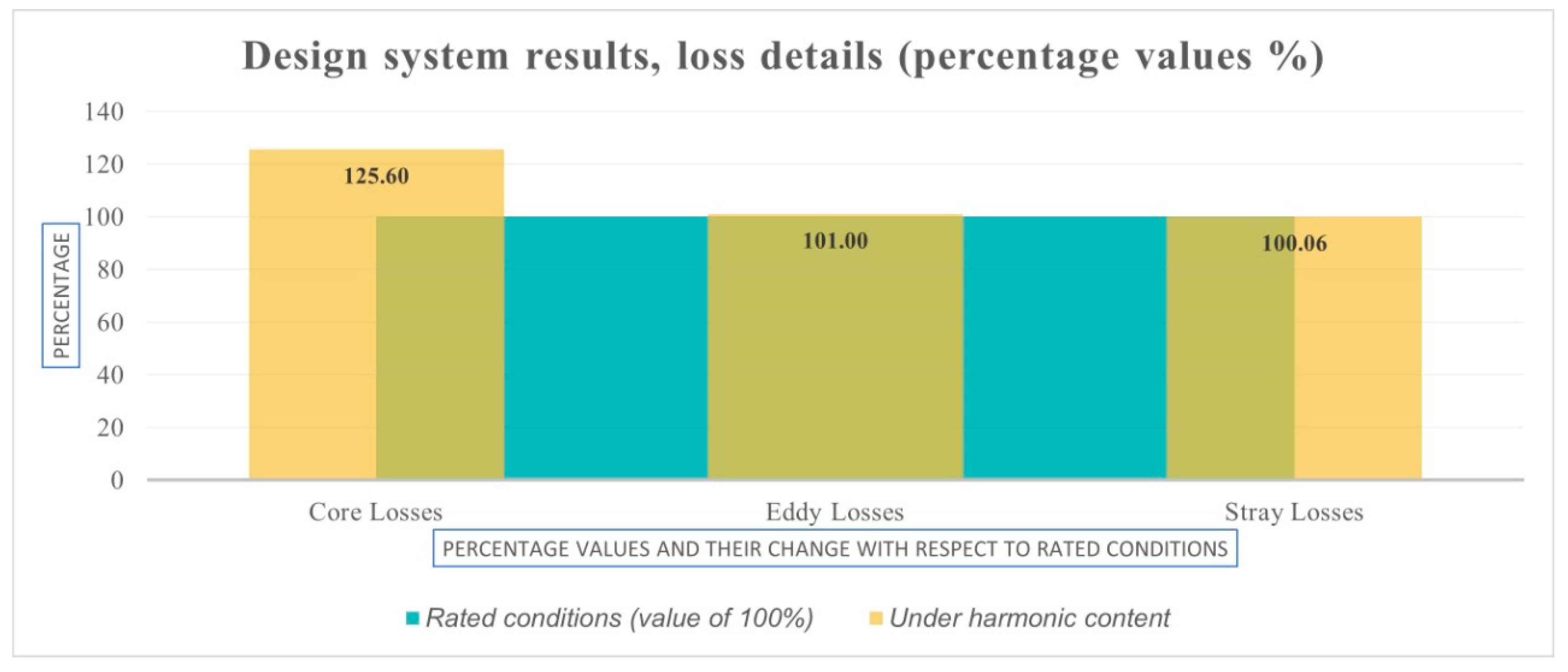
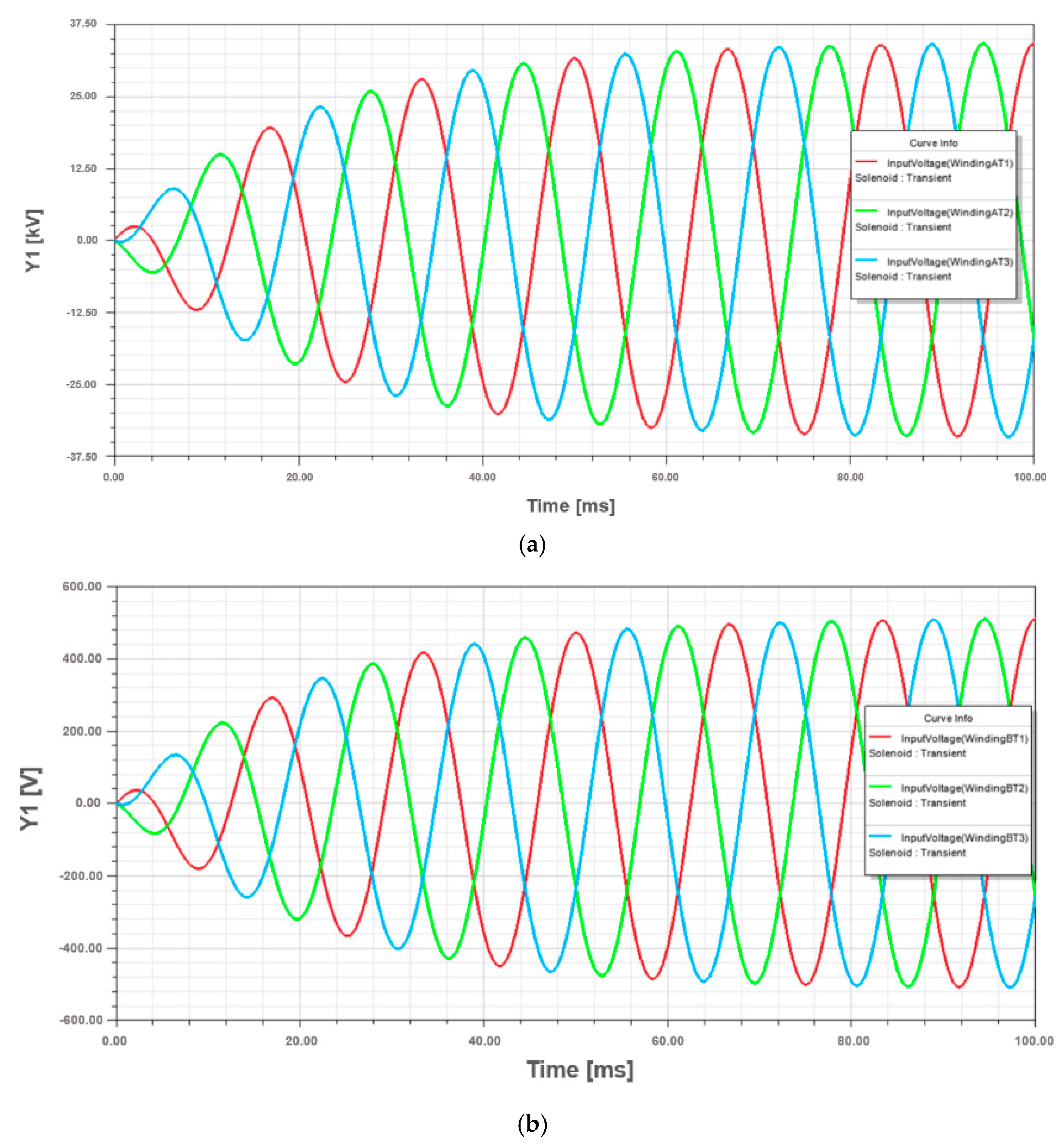
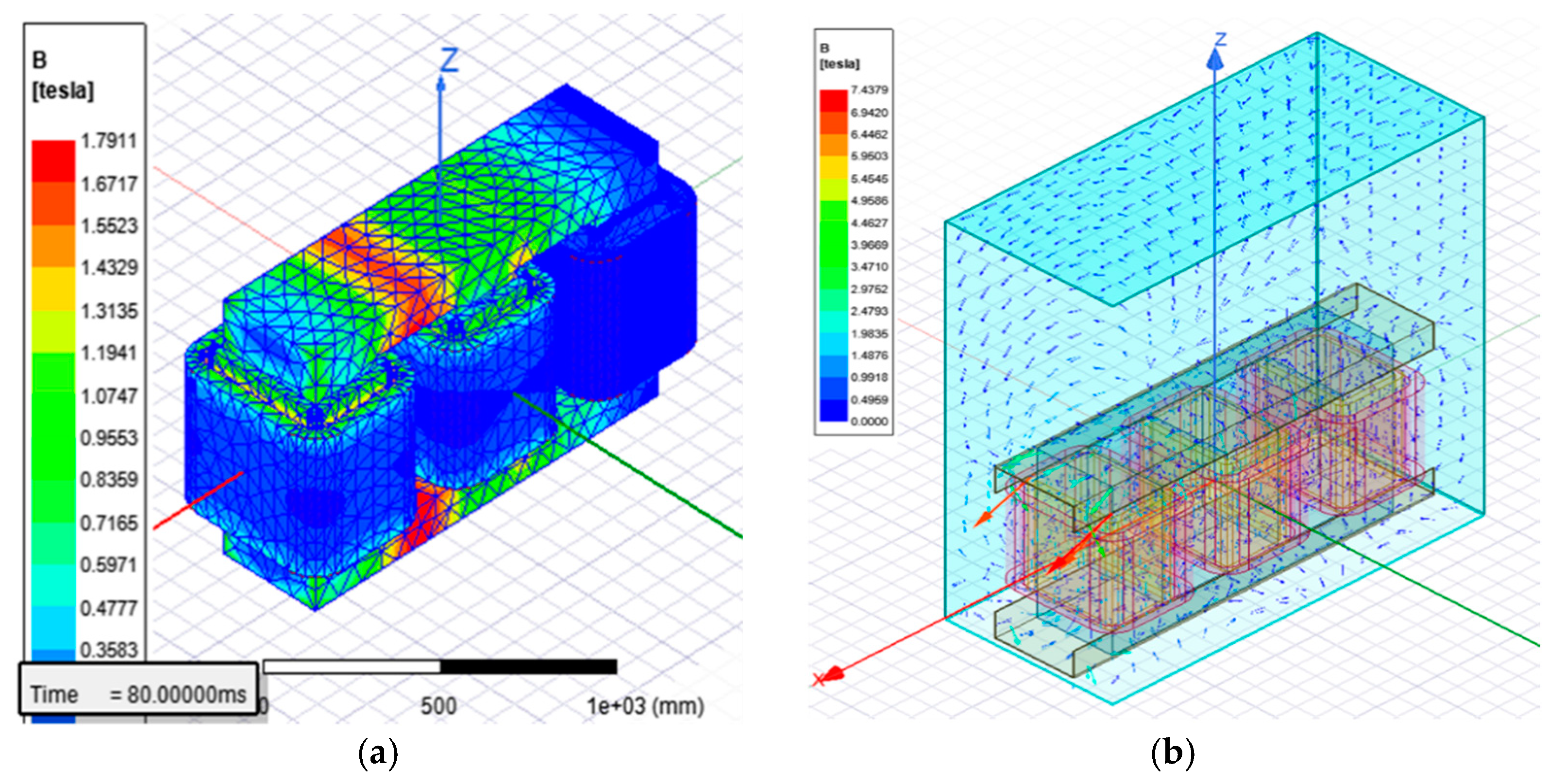
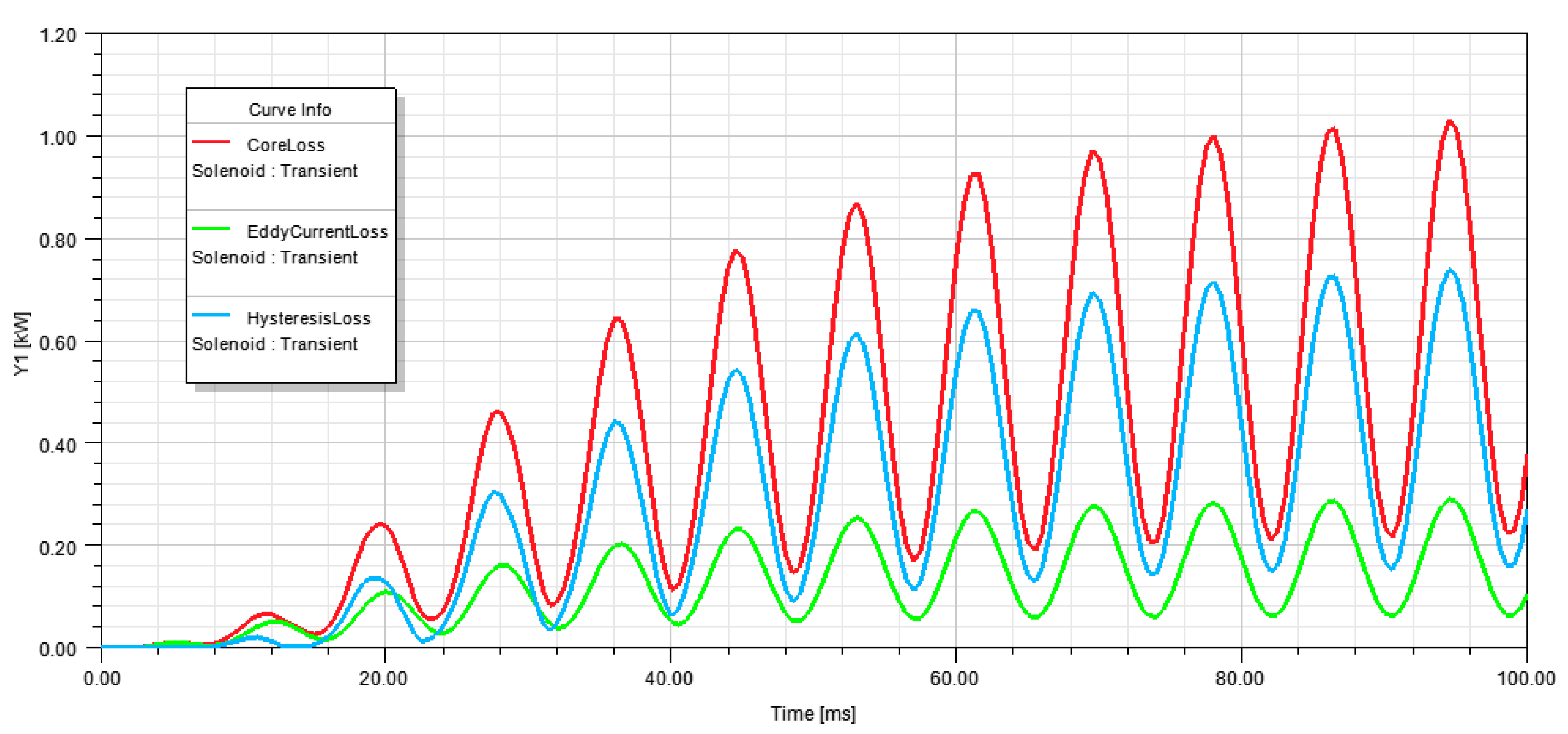
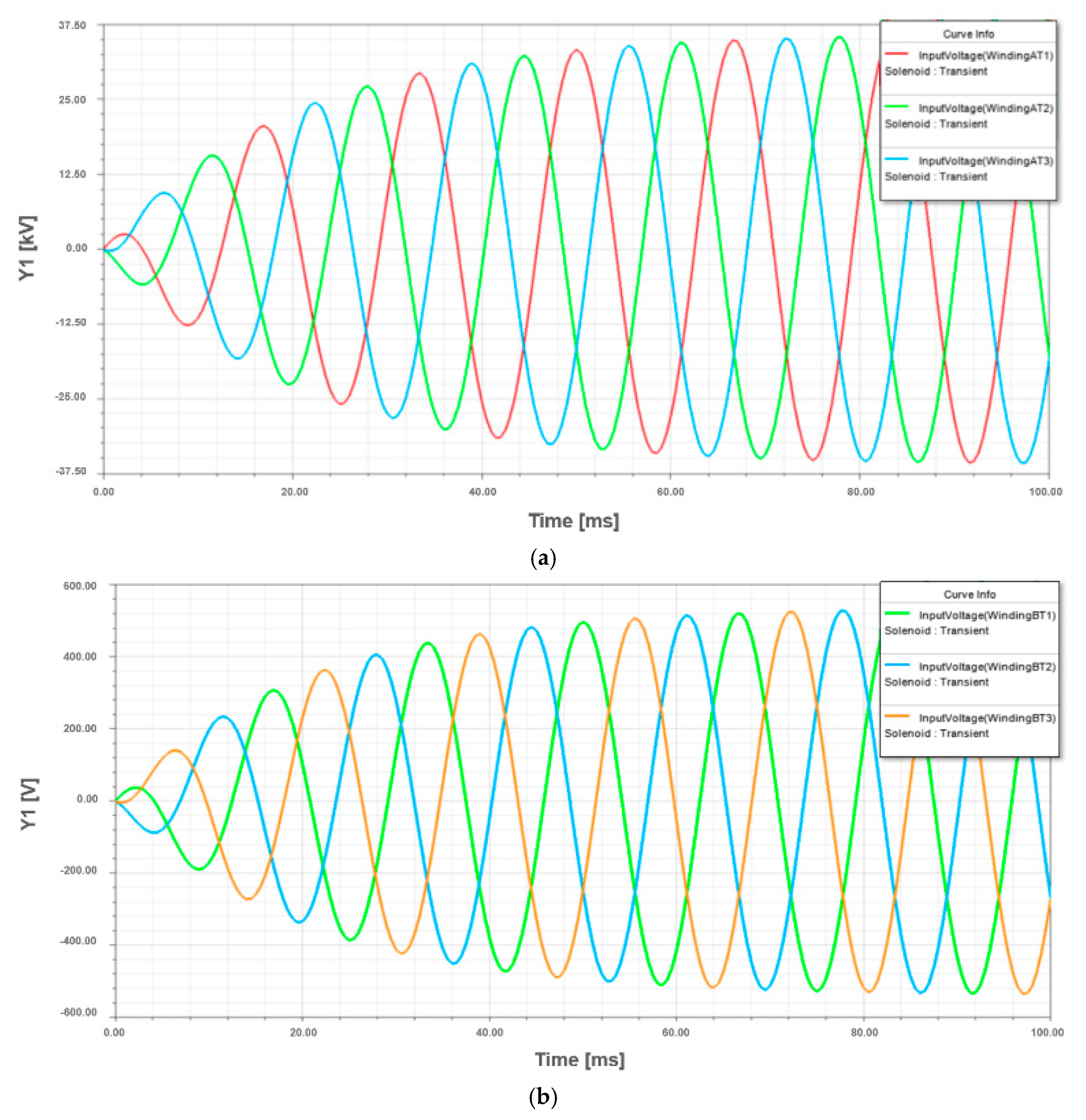


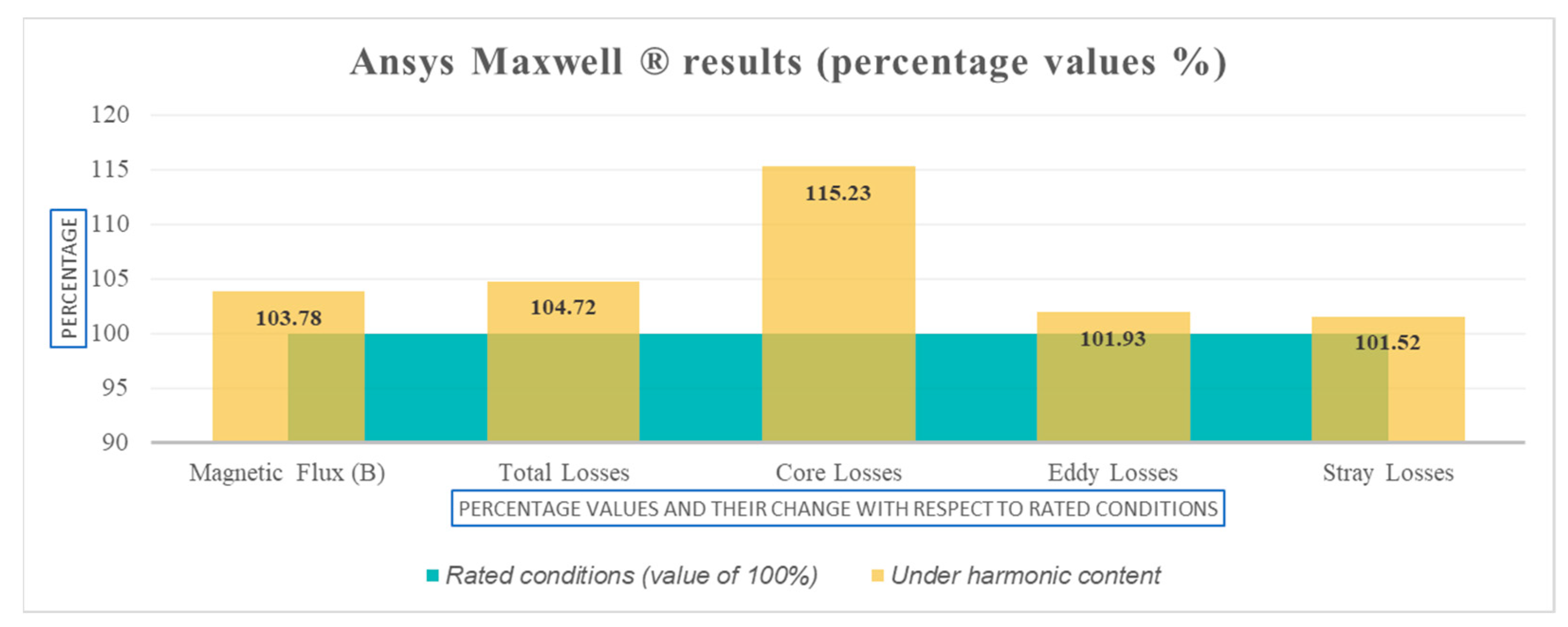
| Losses | Watts |
|---|---|
| 4088.4 | |
| 635.8 | |
| 14,407.8 | |
| 1768 | |
| 20,900 |
| Design Parameters | Value |
|---|---|
| Apparent Power | 2781.057 kVA |
| High voltage (HV) winding current. | 26.866 A |
| Low voltage (LV) winding current. | 2428.53 A |
| Transformer Winding | |
|---|---|
| HV winding | 36,211.7 V |
| LV winding | 381.72 V |
| Losses | Watts |
|---|---|
| 5135.15 | |
| 642.18 | |
| 14,407.8 | |
| 1769.07 | |
| 21,954.2 |
| Transformer Load (%) | Harmonic Profile Efficiency (%) |
|---|---|
| 25 | 99.12 |
| 50 | 99.33 |
| 75 | 99.30 |
| 100 | 99.21 |
| Main Final Design Parameters | Std Design Design System Tool | Std Design ANSYS Maxwell | Harmonic Profile Design Design System Tool | Harmonic Profile Design ANSYS Maxwell |
|---|---|---|---|---|
| B (Tesla) | 1.7141 | 1.7911 | 1.798 | 1.8614 |
| Total Losses (W) | 20,900 | 24,991 | 21.954 | 26,170 |
| ɳ (%) | 99.25 | - | 99.21 | - |
| HV winding max voltage | 34,505 | 34,705 | 36,211 | 36,410 |
| LV winding max voltage | 363 | 520 | 381 | 530 |
| Vper-turn | 40.42 | 40.42 | 42.41 | 42.41 |
| 1 | 1 | 1.04945 | 1.049 |
Publisher’s Note: MDPI stays neutral with regard to jurisdictional claims in published maps and institutional affiliations. |
© 2021 by the authors. Licensee MDPI, Basel, Switzerland. This article is an open access article distributed under the terms and conditions of the Creative Commons Attribution (CC BY) license (http://creativecommons.org/licenses/by/4.0/).
Share and Cite
Macías Ruiz, I.R.; Trujillo Guajardo, L.A.; Rodríguez Alfaro, L.H.; Salinas Salinas, F.; Rodríguez Maldonado, J.; González Vázquez, M.A. Design Implication of a Distribution Transformer in Solar Power Plants Based on Its Harmonic Profile. Energies 2021, 14, 1362. https://doi.org/10.3390/en14051362
Macías Ruiz IR, Trujillo Guajardo LA, Rodríguez Alfaro LH, Salinas Salinas F, Rodríguez Maldonado J, González Vázquez MA. Design Implication of a Distribution Transformer in Solar Power Plants Based on Its Harmonic Profile. Energies. 2021; 14(5):1362. https://doi.org/10.3390/en14051362
Chicago/Turabian StyleMacías Ruiz, Iván Rafael, Luis Alonso Trujillo Guajardo, Luis Humberto Rodríguez Alfaro, Fernando Salinas Salinas, Johnny Rodríguez Maldonado, and Mario Alberto González Vázquez. 2021. "Design Implication of a Distribution Transformer in Solar Power Plants Based on Its Harmonic Profile" Energies 14, no. 5: 1362. https://doi.org/10.3390/en14051362
APA StyleMacías Ruiz, I. R., Trujillo Guajardo, L. A., Rodríguez Alfaro, L. H., Salinas Salinas, F., Rodríguez Maldonado, J., & González Vázquez, M. A. (2021). Design Implication of a Distribution Transformer in Solar Power Plants Based on Its Harmonic Profile. Energies, 14(5), 1362. https://doi.org/10.3390/en14051362







